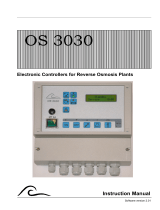2. MONTAJE
2.1 Recepción y conservación
Compruebe que el controlador está intacto a la entrega, y notifique al
transportista inmediatamente, y por escrito, cualquier daño que pudiera
ser achacado a un transporte incorrecto o descuidado. Lleve la máqui-
na a su lugar de instalación, antes de sacarla del embalaje, sujetándo-
la del cuello únicamente por debajo de la base. Abra la caja, saque el
material protector y posteriormente saque la máquina, manteniéndola
en todo momento en posición vertical; quite la bolsa de protección
justo antes de realizar la instalación.
2.2 Posicionamiento
Para la instalación elija la posición más adecuada para la distribución
del vapor, que es la posición que minimiza la longitud de la tubería de
vapor o, en caso de humidificación directa en ambiente utilizando un
distribuidor con ventilador, en la posición cen-
tral del ambiente que se vaya a humidificar.
(ver cap.4). La unidad está diseñada para
montaje en pared, la cual debe ser capaz de
soportar el peso de la unidad en condiciones
de funcionamiento normal (ver pár.12.1).
La carcasa metálica del humidificador se
calienta durante el funcionamiento y la parte
posterior apoyada en la pared puede alcanzar
temperaturas por encima de los 60 °C; asegú-
rese de que la máquina está nivelada y que
se respetan las distancias mínimas indicadas
en el esquema, para que se puedan realizar
las operaciones de mantenimiento necesa-
rias.
ABCDEF
Dimensiones en mm > 300 > 200
>
200
>
400
>
700 <0,5°
2.3 Fijación
El aparato debe ser fijado a la pared utilizando tres tornillos: dos en la
parte superior para la pletina de soporte, y uno en la parte inferior, en
el centro, para fijar la unidad en su
lugar. Para ver las distancias (en mm),
consulte la Fig. 2.3.1 Fije (ver Fig.
2.3.1 y .2) a la pared la pletina de
soporte suministrada con el
humidificador, comprobando que está
horizontal, con un nivel de burbuja; si
se monta en una pared de ladrillo, se
pueden utilizar los tacos de plástico (Ø
8 mm) y los tornillos (Ø 5 mm x L = 50
mm) suministrados.
Cuelgue el aparato del soporte,
utilizando el perfil que se
encuentra en el borde superior
de la parte trasera de la unidad.
Finalmente, fije el aparato a la
pared, utilizando el taladro que
se encuentra en la parte central
trasera de la base; se puede
acceder a éste, fácilmente desde
abajo. Para ver los pesos y las
dimensiones, consulte el párrafo
12.1.
Modelo UE 001...008 UE 009...015 UE 025...045 UE065
X 220 220 310 400
Y 500 590 725 785
Z 115 38
Z’ 112
2. MOUNTING
2.1 Receipt and storage
Check that the humidifier is intact upon receipt and immediately notify
the shipping agent, in writing, of any damage that may be due to
improper or careless transport. Move the humidifier to the place of
installation before removing it from the packaging, grasping the neck
only from below the base. Open the box, remove the layer of protective
material and take out the humidifier, keeping it vertical at all times; only
remove the protective bag when installing the unit.
2.2 Positioning
For installation choose the most suitable position for the steam
distribution, that is the position that minimises the length of the steam
outlet pipe, or alternatively, in the case of direct humidification into the
room using a ventilated distributor, in a
central position in the room being humidified
(see Chap. 4). The unit has been designed for
wall-mounting, and the wall must be able to
support the weight of the unit in normal ope-
rating conditions (see par. 12.1).
The metal casing of the humidifier heats up
during operation, and the rear part in contact
with the wall may reach temperatures of over
60 °C; check that this does not cause any
problems. Make sure the humidifier is level,
and that the minimum spaces are respected
as per the drawing, to allow room for
maintenance operations.
ABCDEF
Dimension in mm
>
300
>
200
>
200
>
400
>
700 <0,5°
2.3 Fastening
The appliance must be wall-mounted using three screws: two upper
screws, for fastening the support bracket, and one lower, central screw,
to fasten the unit into place. For the
distances (in mm), see Fig. 2.2.1.1.
Fasten (see Figs. 2.3.1 and .2) the
bracket supplied with the humidifier to
the wall, checking that it is horizontal
using a spirit level; if the unit is
mounted on a brick wall, plastic screw
anchors (diam. 8mm) and the screws
(diam. 5mm x L= 50 mm) supplied
may be used.
Hang the appliance on the
bracket using the band located
on the top edge of the rear of
the unit.
Finally, fasten the appliance to
the wall using the central hole in
the rear part of the base; this
can be easily reached from
below.
For the weights and dimensions,
see par. 12.1.
Model UE 001 to 008 UE 009 to 015 UE 025 to 045 UE065
X 220 220 310 400
Y 500 590 725 785
Z 115 38
Z’ 112
10
humiSteam - cod. +030221914 rel. 5.2 - 07.11.2005




















